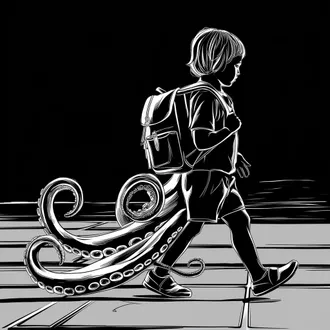The Monster
lays out my definition of the term monster

The Monster: Society’s Unintended Mirror in Contemporary Liberal Systems
In the heart of Millbrook, a once-thriving industrial town now grappling with economic decline, stands the old Wilkinson house. Its peeling paint and overgrown yard are a stark contrast to the neighborhood’s attempts at maintaining appearances. But it’s not the house itself that draws wary glances from passersby - it’s its sole occupant, Frank Wilkinson.
Frank, 62, is a third-generation Millbrook resident, but he might as well be from another planet. Tall and gaunt, with wild, unkempt hair, he roams the streets at odd hours, pushing a shopping cart filled with scavenged electronics and muttering about “cosmic frequencies.” His clothes, a mismatched assortment of decades-old styles, hang loosely on his frame.
During the day, Frank transforms his yard into a labyrinth of antennas and homemade satellites, claiming he’s “boosting the signal to save us all.” The clanging of metal and bursts of radio static emanating from his property have become an unsettling soundtrack to the neighborhood.
Attempts by social services to intervene have proven futile. Frank speaks in a bewildering mix of technical jargon and what seems to be a language of his own invention. Job training programs and therapy sessions have all failed, with Frank insisting that his “work” is too important to abandon.
This scenario illuminates the complex role of the “monster” in pluralistic societies - individuals who dramatically clash with established norms, often through no deliberate choice of their own.
Key attributes of the monster archetype encompass:
- Visible nonconformity: Their appearance or conduct immediately sets them apart, often in unsettling ways.
- Persistent social dysfunction: They struggle to maintain employment, form relationships, or engage in expected social interactions.
- Unintended disruption: Their presence tends to create discord, regardless of their intentions.
- Friction in social contexts: Their interactions frequently result in misunderstandings or conflicts.
- Resistance to social integration: Efforts to incorporate them into conventional systems often prove futile.
The monster archetype reveals a fundamental tension: while their behavior disrupts social norms, their very existence serves to define and reinforce these norms. Frank’s presence in Millbrook forces the community to confront its boundaries of tolerance and inclusion.
It’s crucial to recognize that the monster archetype isn’t necessarily linked to malicious intent. Frank seems genuinely unaware of how his actions impact others. When confronted, he displays confusion or distress, suggesting a deep-seated inability to align with societal expectations.
The emergence of the monster archetype is intrinsically tied to the evolution of pluralistic democratic systems. As these societies developed complex social structures and expectations, the monster emerged as a counterpoint, challenging the limits of social integration and tolerance.
In contrast to rebels, who consciously oppose societal norms, monsters often lack the ability to conform even if they desired to do so. This involuntary nonconformity sets them apart from other societal archetypes and presents unique challenges for communities.
Frank’s presence in Millbrook forces a confrontation with uncomfortable questions. How does a community balance compassion with the need for order? What are the limits of inclusivity in a society that prides itself on diversity? His existence tests the boundaries of tolerance that many contemporary societies claim to uphold.
Reflecting on the monster archetype offers insights into the complexities of social cohesion and the ongoing negotiation between individual differences and collective norms. It prompts us to consider how societies can balance the need for order with the reality of human diversity, and challenges us to examine our own reactions to those who deviate significantly from expected norms.